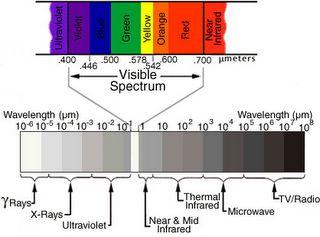Electromagnetic Spectrum

Electromagnetic radiation is a mixture of radiation of different wavelengths and intensities. When this radiation has a wavelength inside the human visibility range (approximately from 380 nm to 740 nm), it is called light. The light's spectrum records each wavelength's intensity. The full spectrum of the incoming radiation from an object determines the visual appearance of that object, including its perceived color. As we will see, there are many more spectra than color sensations; in fact one may formally define a color to be the whole class of spectra which give rise to the same color sensation, although any such definition would vary widely among different species and also somewhat among individuals intraspecifically.
A surface that diffusely reflects all wavelengths equally is perceived as white, while a dull black surface absorbs all wavelengths and does not reflect (for mirror reflection this is different: a proper mirror also reflects all wavelengths equally, but is not perceived as white, while shiny black objects do reflect).
The familiar rainbow spectrum?named from the Latin word for image by Isaac Newton in 1666?contains all those colors that consist of visible light of a single wavelength only, the pure spectral or monochromatic colors.
The frequencies are approximations and given in terahertz (THz). The wavelengths, valid in vacuum, are given in nanometers (nm). A list of other objects of similar size is available.
The color table should not be interpreted as a definite list?the pure spectral colors form a continuous spectrum, and how it is divided into distinct colors is a matter of taste and culture; for example, Newton identified the seven colors red, orange, yellow, green, blue, indigo, and violet, remembered by many school children using mnemonics such as Roy G. Biv and Richard Of York Gave Battle In Vain.
Similarly, the intensity of a spectral color may alter its perception considerably; for example, a low-intensity orange-yellow is brown, and a low-intensity yellow-green is olive-green.

2 Comments:
Cool blog, interesting information... Keep it UP Spin 2 million slot Free quit smoking products auricular stop smoking stop smoking contests
By Anonymous, at 7:00 PM
Anonymous, at 7:00 PM
Excellent, love it! saab dealer Cheap contact lenses eyewear gst qbhtml http://www.lcdprojector1.info Butalbital+online Driveway ice melt install brio handbags 1996 dodge caravan transmission problems cosmetics clinique High speed fax modem Used ovens uk Addiction zoloft
By Anonymous, at 9:14 AM
Anonymous, at 9:14 AM
Post a Comment
<< Home